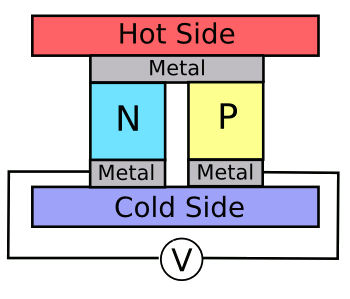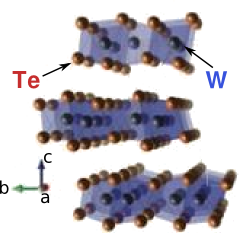Tungsten Telluride
November 3, 2014
In
antiquity,
places were often named after a local characteristic or
deity. The later case is called a
theophorism, from the
Greek word for god (Θεος, theos) and bearing (φορος, phoros). Sometimes the connection is not that apparent, as in the name for
Woodbridge, a
town in
Suffolk,
England. The name is a variant of its original name, Wodenbrycge (Woden's Bridge).
Woden (a.k.a.,
Odin) is the
Norse/Germanic/Anglo-Saxon mythology equivalent of
Jupiter and
Zeus.

Norse god, Odin, as depicted in an 1825-1827 sculpture by H. E. Freund (1786-1840).
Odin, like Zeus, was the father of the gods and the ruler of the abode of the gods.
For Odin, the abode of the gods was Asgard. For Zeus, it was Mount Olympus.
(Via Wikimedia Commons.)
You would think that the town of
Telluride, Colorado was named after the
telluride minerals found in
Colorado, but that's not the case. Telluride was established near a
gold deposit, and the area was later mined for
silver. It was subsequently mined for
zinc,
lead and
copper, all of whose
ores are associated with silver. However,
tellurium and its cousin
chalcogenide elements found in the same column of the
periodic table, were not mined there.
Tellurium is used in the following applications:
• Tellurium is an important component of iron alloys, such as stainless steel, since it promotes machinability.
• Cadmium telluride (CdTe) is a highly efficient photovoltaic material, so it's used in solar panels. Its chalcogenide sister, Selenium, is used in CIGS (Copper indium gallium selenide) solar cells.
• Mercury cadmium telluride is an important infrared detector at wavelengths as long as 12 μm. It's used as the enabling component in forward looking infrared (FLIR) imaging devices and sensors used in a variety of military and other applications. Lead telluride is used, also, in far-infrared photodetectors.
• In computer applications, tellurium is used in phase-change materials in rewritable optical discs, such as DVD-RW. It's also used as a phase-change memory material.
• Bismuth telluride (Bi2Te3) and lead telluride (PbTe) are Thermoelectric materials.
Thermoelectric energy-harvesting is an important niche area for tellurium compounds, and it's enabled
electrical power generation for many
spacecraft. It's also used on
planetary rovers, such as the
Curiosity rover, the
robotic science mission that's been on
Mars since August 6, 2012. The Curiosity rover uses thermoelectrics to convert the heat of the
radioactive decay of the
plutonium isotope,
plutonium-238, (
238Pu) in
plutonium dioxide. I wrote about this power source in a
previous article (Curiosity Rover Power, November 5, 2012).
The
energy output of plutonium-238 by radioactive decay is 560
watts/
kg, the
half-life of plutonium-238 is 87.7
years, so the power source remains fairly active for many years. Conversion of the heat to electricity is through the
Seebeck effect. Lead telluride is very effective as a Seebeck material, since it has a reasonably high
electrical conductivity, but a low
thermal conductivity. As we know from the
second law of thermodynamics, we need a
temperature differential to do useful work, so the low thermal conductivity is important.
A basic thermoelectric cell, as shown in the figure, has
junctions of
n- and
p-doped lead telluride, but the
energy conversion efficiency is low. The initial power output of the Curiosity rover source was 2,000 watts, but this produced just a little more than a hundred watts of electrical power against the Mars
ambient temperature.

(Image by the author, rendered using Inkscape.)
Telluride compounds still have some surprises, as recent
research on
tungsten telluride (WTe
2) by
scientists at
Princeton University (Princeton, New Jersey) and
Brookhaven National Laboratory (Upton, New York) has shown. In this case, tungsten telluride was found to exhibit
magnetoresistance, which is the change in
electrical resistance in response to an
applied magnetic field. Magnetoresistance is a useful effect that's presently used in the
read heads of
computer hard drives, and in various sensors. What's interesting is that the magnetoresistance effect in tungsten telluride, unlike that for other materials, was found not to
saturate at any applied magnetic field.[1-2]
Mazhar Ali, a
graduate student in the
laboratory of Princeton University
professor,
Robert Cava, first noticed this effect, so follow-up studies were in order.[2] Measurements showed that there was an extremely large positive magnetoresistance of 452,700
percent at 4.5
kelvin for a magnetic field of 14.7 tesla, and 13 million percent at 0.53 kelvin for a magnetic field of 60 tesla.[1] Electron microscopy by
Jing Tao of Brookhaven National Laboratory showed the presence of paired
tungsten atoms, tungsten
dimers, arranged in chains (see figure). It's
conjectured that the material's lack of saturation arises from a nearly perfect balance of
electrons and
holes. Because of this chain structure, tungsten telluride shows this large magnetoresistance only when the magnetic field is applied in a certain direction.[2]

Crystal structure of tungsten telluride (WTe2), a non-magnetic, layered, transition-metal dichalcogenide.
(Image: Cava Laboratory/Princeton University, modified for clarity.)
Scientists as playful people, as the example of
Richard Feynman demonstrates. Since we already have "
giant magnetoresistive" materials (up to about 25,000% change) and "
colossal magnetoresistive" materials (up to about 100,000% change), the research team proposed the
adjective "ludicrous," instead. The inspiration for this term was the
movie, "
Spaceballs,"[3] in which the term, "ludicrous speed," was used for a rapid type of travel.[2] The
journal editors rejected this term (after all, it was
Nature, which is probably the most prestigious
scientific journal), so the effect was termed, "large magnetoresistance."[2]
This research was funded by the
Army Research Office and the
US Department of Energy's Basic Energy Sciences (DOE BES) project "Science at 100 Tesla."[2]
References:
- Mazhar N. Ali, Jun Xiong, Steven Flynn, Jing Tao, Quinn D. Gibson, Leslie M. Schoop, Tian Liang, Neel Haldolaarachchige, Max Hirschberger, N. P. Ong, and R. J. Cava, "Large, non-saturating magnetoresistance in WTe2," Nature, vol. 514, no. 7521 (October 9, 2014), pp. 205-208.
- Unstoppable magnetoresistance, Princeton University Press Release, October 9, 2014.
- Spaceballs (1987, Mel Brooks, Director) on the Internet Movie Database.
Permanent Link to this article
Linked Keywords: Antiquity; toponymy; deity; theophoric; theophorism; Greek language; Greek word; Woodbridge; town; Suffolk; England; Woden; Odin; Norse mythology; Norse-Germanic-Anglo-Saxon mythology; Jupiter; Zeus; Norse god; sculpture; Asgard; Mount Olympus; H. E. Freund; Wikimedia Commons; Telluride, Colorado; telluride mineral; Colorado; gold; silver; zinc; lead; copper; ore; tellurium; chalcogenide; element; periodic table; iron alloy; stainless steel; machinability; cadmium telluride; energy conversion efficiency; efficient; cadmium telluride photovoltaic; photovoltaic material; solar panel; selenium; copper indium gallium selenide solar cell; CIGS; solar cell; mercury cadmium telluride; infrared detector; wavelength; micrometer; μm; forward looking infrared; electronic imager; imaging device; sensor; military; lead telluride; far-infrared; photodetector; computer; phase transition; phase-change; material; optical disc; rewritable optical disc; DVD-RW; phase-change memory; bismuth telluride; lead telluride; thermoelectric material; thermoelectric; energy-harvesting; electric power; electrical power; electric generator; generation; spacecraft; planetary rover; Curiosity rover; robotic spacecraft; science; Mars; radioactive decay; plutonium; isotope; plutonium-238; plutonium dioxide; energy; watt; kilogram; kg; half-life; year; Seebeck effect; electrical conductivity; thermal conductivity; second law of thermodynamics; temperature; junctions; n-type semiconductor; p-type semiconductor; lead telluride; energy conversion efficiency; ambient temperature; bismuth; tellurium; toxicity; toxic; Inkscape; research; tungsten telluride; scientist; Princeton University (Princeton, New Jersey); Brookhaven National Laboratory (Upton, New York); magnetoresistance; electrical resistance; applied magnetic field; disk read-and-write head; read head; hard disk drive; computer hard drive; magnetic saturation; saturate; Mazhar Ali; postgraduate education; graduate student; laboratory; professor; Robert Cava; percentage; percent; kelvin; Jing Tao; tungsten; dimer; conjecture; electron; holes; Richard Feynman; giant magnetoresistive; colossal magnetoresistive; adjective; movie; Spaceballs; journal; editor; Nature; scientific journal; Army Research Office; US Department of Energy; Basic Energy Sciences.